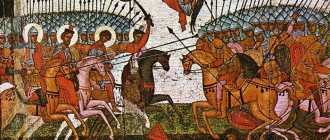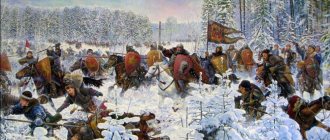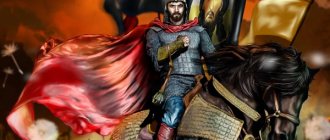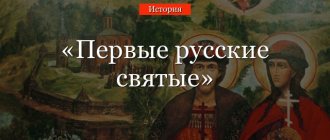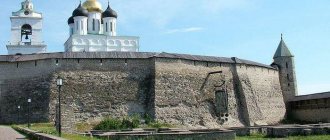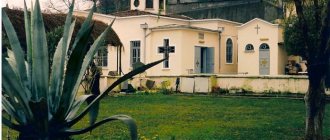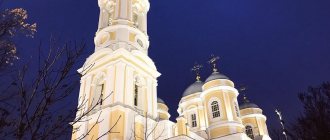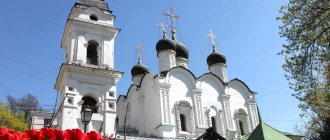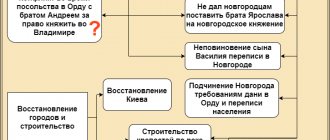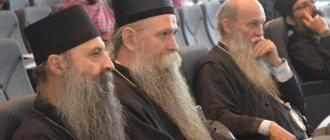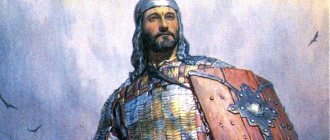Life of the Righteous Prince Yuri Vsevolodovich
Prince George was born in 1119 in the city of Vladimir Klyazmensky. He was one of the sons of Grand Duke Vsevolod Yuryevich Big Nest, who was the brother of Saint Prince Andrei Bogolyubsky, and Grand Duchess Maria Shvarnovna. Historical chronicles say that when the little prince was 3 years old, a prayer service was served, his hair was cut and he was put on a horse, which meant that from that moment on, men were involved in his upbringing.
When the prince turned 19 years old, his mother fell ill and, having taken monastic vows in the Dormition Princess Monastery she founded, went to the Lord. On April 14, 1212, his father also died, bequeathing the grand-ducal throne to George before his death, even though he was not his eldest son. The elder brother Konstantin did not accept this at all. But soon enmity broke out between them for another reason: their younger brother Yaroslav was removed from the Novgorod reign. George supported his younger brother, while Konstantin sided with the Novgorodians. Konstantin emerged victorious from this confrontation, but was favorable to George and Yaroslav - he gave one Suzdal, the other Pereyaslavl. Before his death in 1218, Constantine entrusted his children to his younger brother George, who took care of them all his life, like his own father. George was distinguished by his ability to pacify other princes who were dissatisfied with something. His military successes in campaigns against Volga Bulgaria and Mordva are known. The prince also became the founder of Nizhny Novgorod, which he founded in 1221.
Grand Duke Georgy Vsevolodovich travels on boats around the newly conquered lands at the mouth of the Oka River. Artist G. Maltsev
In 1237, the Tatar-Mongol hordes of Batu moved to Rus'. During the wars, the Tatars ravaged Ryazan and Moscow and captured his son Vladimir. Prince George left Vladimir, leaving his sons Mstislav and Vsevolod at the head of the defense of the city, and stood on the City River with his nephews - the sons of his late brother Konstantin, expecting military help from his brothers Yaroslav, Svyatoslav and John. However, at this time he received terrible news: the city of Vladimir fell, the Tatars killed the entire family of the prince - his wife Agafya, sons Vsevolod and Mstislav, daughter - Princess Theodora, daughters-in-law - princesses Maria and Christina, all his young grandchildren. After this news, life for Prince George did not become pleasant.
Meanwhile, on February 4, 1238, the Tatar army led by Nayon Burundai approached the City River and attacked the Russian army. In that brutal battle, the Mongols won a complete victory, and the prince himself was killed and beheaded. One nephew, Prince Vsevolod Yaroslavsky, also fell in battle, and the second, Vasilko Rostovsky, was taken into captivity and soon also killed.
Death of Grand Duke Georgy Vsevolodovich. Rice. V. Vereshchagina
After Batu’s hordes fled, Rostov Bishop Kirill II, who was hiding from Tatar atrocities in the Beloezersky Monastery, took the incorrupt body of the prince, and then his honorable head, and buried him in the Rostov Cathedral. Two years later, brother Yaroslav solemnly transferred the honorable remains of George to Vladimir. During this solemn transfer, a miracle happened in front of everyone: while being placed in the coffin, the head fused to the body of the martyr prince:
His holy head is so closely attached to his honest body, as if there is not a trace of cutting off on his neck, but all the parts are intact and inseparable... Also, his right hand is stretched out to see, with it, as if alive, showing the feat of his accomplishment (“Book Steppe royal genealogy").
This miracle was confirmed during the autopsy of the relics in February 1919: an autopsy witness writes that “Grand Duke George, who was killed in a battle with the Tatars... in which his head was cut off, the latter turned out to be attached to the body, but in such a way that it is possible It was noticeable that it had previously been cut off, so that the cervical vertebrae were displaced and fused together incorrectly.”
Monument to St. Prince George (Yuri) Vsevolodovich and Bishop Simeon of Suzdal in the Nizhny Novgorod Kremlin
On January 22, 1645, the incorruptible relics of the Holy Blessed Prince George were found: they, in the presence of Patriarch Joseph and Tsar Mikhail Fedorovich, were transferred from a stone tomb in the altar of one of the aisles of the Assumption Cathedral in Vladimir, and placed in an expensive silver and gilded reliquary in the center of the cathedral. The inscription on the shrine says that the reason for the glorification of the saint was his appearance to the patriarch.
Cancer with the relics of St. blgv. Prince Georgy Vsevolodovich in the Assumption Cathedral in the city of Vladimir. Photo by V. Alekseev. 2009
In 1774, one of the chapels was consecrated in this cathedral in honor of the Holy Prince George.
Life of the Holy Prince
He was his father's second son, born in 1187. When his father died, he had to ascend the Vladimir throne. There were always civil strifes about which heir would receive the throne and which lands would be given to him.
This time was no exception. The elder brother was very angry, since seniority was not given to him. Disputes arose between them more than once, but soon the brother died and George began to rule legally. He was credited with military valor and piety. After another Tatar raid and the defeat of Moscow, as well as Ryazan, he decided to move with his army against them. The city was left to two sons and older husbands. He set off on his own.
Having set up camp near the City River, he accepted the battle. But the day before he received terrible news that the city was destroyed and his sons were killed. This brought him quite a bit of grief and he turned to the Lord in prayer. His request was for martyrdom. And so it happened. He died from beheading in battle. A certain period of time later, a bishop passed through the battlefield. By appearance, he recognized the ruler's body and brought it to Rostov.
The best article for you, go to: Saint Theodosius the Great
The burial process took place in the cathedral church of the city. Afterwards the head was identified and placed in the coffin. Two years later, a decision was made to transfer the remains to the Vladimir Assumption Cathedral. In 1645 it was discovered that the body remained incorrupt. After this, the relics of George Vsevolodovich were placed in a silver shrine and canonized.
Troparion, kontakion and canon to the blessed prince Yuri Vsevolodovich
Troparion, tone 8:
At the height of the great reign, sitting, appearing, shining with piety and faith for his fatherland, like the sun, according to the Holy Trinity, he was kindled with jealousy and, having suffered greatly for his faith, shed his blood. Thus, your cut off head for Christ testifies to reality about you, clinging to your body after death, with which your relics remain incorruptible to this day, from which you exude healing to our souls and bodies. But since you have boldness towards Christ, passion-bearing George, unceasingly pray for your power and your relatives to remain harmless through your prayers.
Kontakion, tone 8:
Befitting Christ's death and desiring to drink the cup like the Life, having courageously fought for the Worthless, despising the earthly kingdom, having suffered from the godless barbarians to death, St. George the Bogomudre. Therefore, pray to our Christ-loving king to be saved through your prayers.
Library of the Russian Faith Canon to the Holy Blessed Prince George →
Read online
Holy place
Like in honor of others, a church was built for him. The Church of St. George Vsevolodovich is located in the Nizhny Novgorod Metropolis of the Russian Orthodox Church. A large number of pilgrims go there, as many hope for God's grace.
In addition, reading holy texts in special places has more power than simply reciting them somewhere. But we should not forget that the power of faith must also be taken into account here. Here is the text of the most common prayer said.
O God-chosen miracle worker, glorious servant of Christ, champion of the Orthodox Church. Defender of the Russian Kingdom, Grand Duke George! On bended knee, we pray to you: look upon us sinners who have resorted to your intercession, hear this little prayer of ours and with your warm intercession implore the Merciful God, Who stands before Him as an Angel and with all the saints, may he preserve us in the unity of the Orthodox Church and establish us in our hearts our spirit of right faith and piety, and will deliver us from every evil temptation. According to your great love, with which you have loved your neighbor, ask the all-generous Lord for peace and prosperity for your Fatherland, and ours together; to all of us, unworthy, who zealously fall to you, a godly and serene life.
O our holy intercessor, do not leave us weak and helpless, pray for us to the Lord and the Most Pure Lady Theotokos, move with you to pray for us your God-glorified relatives, the holy princes Andrei and Gleb, with them, together with them, you rest here on the earth with incorruptible relics and on heaven, stand before the Throne of the Heavenly King, may He all-generously grant us everything we need for temporal and eternal benefit; may he not repay us according to our deeds, but, out of His ineffable love for mankind, may He forgive our sins, may He deliver us from all need and sorrow, sorrow and illness; May he bestow on us good intentions and the strength to struggle in correcting our lives, and in the future may he grant us permission to enter the Kingdom of Heaven and glorify the All-Holy Name of the Father and the Son and the Holy Spirit forever and ever. Amen.
The days of his veneration are considered to be February 17, March 17 and July 6. The peculiarity of this place is that the construction of the temple is just underway, but the services are held in a carriage, which acts as a kind of shelter for everyone. After all, they say correctly that it doesn’t matter what surrounds you, but what’s important is what’s inside you.
Holy Blessed Prince George of Vladimir. Icons
Holy Blessed Prince George of Vladimir. Icon. Rus. Around 1645 Tretyakov Gallery. Moscow
Holy Blessed Prince George of Vladimir. Fresco. Archangel Cathedral of the Moscow Kremlin. XVII century
Pantocrator with the falling saints. Princes Alexander Nevsky and Georgy Vladimirsky. Icon. Rus. Mid-17th century (circa 1649-1654). From the Assumption (Bogoroditskaya) Church in Vladimir St. George of Vladimir. Sewing. Rus. XVII century
Saint George of Vladimir. Icon. Russia. XIX century
Holy Blessed Prince George of Vladimir
Yuri (George) Vsevolodovich (1189-1238) - Grand Duke of Vladimir - 1212-1216. and 1218-1238
Vel. book martyr Georgy Vsevolodovich. Icon. 1645
Yuri is the third son of the Grand Duke of Vladimir Vsevolod Yuryevich Big Nest from his first marriage to Maria Shvarnovna.
He was born in Suzdal on November 26, 1187, according to the Ipatiev Chronicle, and according to the Laurentian Chronicle - in 1189. He was baptized by Bishop Luke. On July 28, 1192, Yuri was tonsured and on the same day he was mounted on a horse; “And there was great joy in the city of Suzdal,” the chronicler notes on this occasion. In 1208 or 1209, he completely defeated the Ryazan princes, who were devastating the Moscow region, near the Drozdna (Trostna) River. In 1210, he took part in a campaign against the Novgorodians, who imprisoned his brother, Svyatoslav, and called Mstislav Mstislavich Udatny to reign; peace, however, was concluded without bloodshed. In 1211, Yuri married Princess Agathia Vsevolodovna, daughter of Vsevolod Svyatoslavich Chermny, Prince of Chernigov; The wedding took place in Vladimir, in the Assumption Cathedral, by Bishop John. 1212-1217
- Grand Duke of Vladimir. After his death (1212), Vsevolod III appointed his second son, Yuri, as his successor, and not the eldest, Konstantin, because the latter did not want to take Vladimir without his beloved Rostov.
A fight broke out between the older brothers, in which the younger brothers also took part. Yuryev Principality (c. 1212-1345) - the capital of Yuryev-Polsky. Uglich Principality
(1216-1591) - the capital of Uglich.
Yaroslavl Principality
(1218-1463) - capital Yaroslavl.
Already in 1212, Yuri released from captivity the Ryazan princes captured by his father in 1208, including Ingvar and Yuri Igorevich, who came to power in Ryazan as a result of the struggle of 1217-1219. and became Yuri's allies. In 1214, the Vladimir diocese was formed by the will of the Grand Duke of Vladimir Georgy Vsevolodovich. Since 1149 Rostov, Suzdal and Murom diocese. Since 1164 (1172) Rostov and Murom diocese. Since 1198 Rostov, Suzdal and Vladimir diocese. Since 1213 (1214) Rostov, Pereyaslav and Yaroslavl diocese. Since 1214 Vladimir and Suzdal diocese. Since 1226 Rostov and Yaroslavl diocese. Since 1228 Suzdal, Vladimir and Pereslavl-Zalessk diocese. In 1215, Yuri established a special diocese for the Vladimir-Suzdal region in order to eliminate its ecclesiastical dependence on Rostov. Abbot Simon
was installed as bishop .
Simon was dedicated from the abbots of the Vladimir Nativity Monastery in Kyiv by Metropolitan Matthew. The newly installed Bishop of Vladimir and Suzdal in 1214 placed his residence in the same place where he had previously been abbot, i.e. in the Mother of God Nativity Monastery in Vladimir. Saint Simeon is the author of eight narratives about the Pechersk monks, which laid the foundation for the Kiev-Pechersk Patericon - the first Russian “Fatherland”. Bishop Simon died on May 22, 1226 and was buried in the Assumption Cathedral in the city of Vladimir. Mitrofan
, abbot of the Vladimir Nativity Monastery , dedicated by Metropolitan Kirill II of Kiev.
The saint took a lot of care about decorating the Vladimir Assumption Cathedral. Georgy Vsevolodovich came to the defense of Yaroslav, on whose side were the younger Vsevolodovichs Svyatoslav and John, as well as Blgv. book Muromsky Davyd (Peter) Georgievich. Mstislav Udaloy took the side of Konstantin. Yuri and his younger brothers suffered a strong defeat at Lipitsa in 1216. Yuri, having killed three horses, rode on the fourth at noon on April 22, Friday, to Vladimir, sad, exhausted in only a shirt (he threw off his outer dress on the road, as it slowed him down in his flight). The people of Vladimir did not recognize their prince the first time: his appearance was so unusual. Not expecting defeat, they mistook him for a princely messenger, hastening to please them with the news of victory. “Ours will prevail,” they shouted enthusiastically, following the horseman approaching the city. But what was their surprise when they recognized him as the prince himself and in such a pitiful form. “Strengthen the walls, lock the city,” were the first words of George that reached the ears of the people of Vladimir. But who was to strengthen and defend the city? Everyone capable of carrying weapons was taken on the march. Remained in the city: spiritual, decrepit elders, children, and women. Instead of joy, there was crying in the city; In the evening and into the night, ordinary people began to come running, one would come running wounded, another would kick. And then bitter complaints were heard against Yaroslav, the main culprit of the disaster: “We suffered such a misfortune from you, it is said about your perjury: come, birds of the sky, feed on human blood, animals eat human flesh.” The unfortunate prince asked the citizens not to hand him over to the victors. He wanted to leave the city of his own free will. The people of Vladimir sympathized with the prince, but could not help him in any way: they only promised not to hand him over to Constantine. 1217 - prince in Gorodets Radilov.
The winners were in no hurry to come to Vladimir.
They spent the whole day at the site of the massacre, probably cleaning up the dead bodies, and only on Sunday, the third day after the battle, April 24, they approached Vladimir and besieged it. On the night from Sunday to Monday there was a fire in the prince's palace. Despite the strong desire of the Novgorodians and Smolensk residents to take Vladimir by storm, Mstislav did not allow them to do this and saved the city from defeat. The next night, Tuesday, the fire in the city repeated again: it caught fire opposite the place where the Smolyans were encamped, and burned until daylight. This time the Smolensk prince did not allow his people to enter Vladimir by surprise. The victorious princes were confident that George himself would surrender the city to them and ask them for peace. On Wednesday morning (April 27), Yuri came out to the winners with rich gifts; “Brothers, I beat you with my brow, give you life and feed me with bread.” Constantine solemnly entered Vladimir, led the inhabitants to the cross, reconciled Yaroslav with Mstislav, and gave Yuri Gorodets Radilov on the Volga. Before leaving Vladimir, Georgy Vsevolodovich entered the Cathedral Church, where, in front of the miraculous icon of the Mother of God, he poured out all his sadness in prayerful cries and, shedding tears, fell on the coffin of his parent. “God judge my brother Yaroslav for bringing me to this,” he said, leaving the temple, then sat down with his family in the boat and down the river. Klyazma went to his new destiny. Among the few friends who wished to follow him was the Bishop of Vladimir, the virtuous Simon, who did not want to leave his prince in misfortune. Having seen off Georgy Vsevolodovich, the residents of Vladimir opened the gates to the victors and met them with a procession of the cross. 1217-1219
- Prince of Suzdal .
Soon after his accession to the throne, Constantine asked George to come to him in Vladimir for a friendly meeting. George did not hesitate to answer the call and, out of his kindness, sincerely forgave his brother. Both brothers, in the words of one writer, during their meeting “were wrapped up and cried for many hours,” entered the cathedral church of the Mother of God, where, at the tomb of their parent, they sealed their reconciliation with prayer and kissing the cross. Constantine assigned another inheritance to George, the city of Suzdal, and declared him heir to his throne. George, for his part, gave his word to Constantine to replace his father in the person of his children when he led. Prince of Vladimir. Consoled, George left with his family and court for Suzdal on September 11, 1217. On February 2, 1219, Constantine died, causing general sadness among the people; The chronicle says this: “they cried with great tears - the boyars, as the intercessors of their land, the servants, as for a feeder and master, the wretched and monks, as for their consolation and clothing for their nakedness.” Yuri sat down in Vladimir. 1219-1238
- Grand Duke of Vladimir . After death he led. Prince Konstantin, the people of Vladimir kissed the cross of his brother Georgy Vsevolodovich, who, after a short break, assumed his rights as a grand duke for the second time. Together with him, his inseparable companion, Bishop Simon, arrived from Suzdal. The second accession of Georgy Vsevolodovich to the grand-ducal throne took place under favorable circumstances. Although northeastern Rust still remained divided into appanages and even into a large number of them, since, after the death of Constantine, the Rostov principality was divided between his two sons; but, ruled by princes connected by blood ties, she did not particularly suffer from this. None of the chronicles says that the appanage princes were dissatisfied with their inheritances; on the contrary, it is known that they revered George, as the eldest in the family, as a father and acted in everything according to his will. The Volga Bulgarians took advantage of the civil strife that existed in the Vladimir principality after the death of Vsevolod, again began to disturb the Russian possessions and in 1217 reached Ustyug, which belonged to the Vladimir prince. The first thing George did upon ascending the throne was to pacify the Bulgarians. For this reason, in 1220, he equipped a large army and sent it on a campaign under the leadership of his brother, Svyatoslav Yuryevsky. It reached the city of Oshel on the Volga and burned it. At the same time, the Rostov and Ustyug regiments along the Kama entered the land of the Bulgarians and destroyed many cities and villages. At the mouth of the Kama, both armies united and returned home. The Grand Duke and his children went to meet the victors in Bogolyubov, he himself brought them into the capital with due honor, generously presented them with gold, silver and materials and arranged a cheerful three-day feast in their honor. That same winter, the Bulgarians sent envoys to ask for peace, but the experience of previous years had already shown that peace with this restless people could not be reliable; Yuri refused them. In order to completely stop the Bulgarian raids on Rus', it was necessary to strengthen the eastern borders of the Vladimir-Suzdal principality. In 1221, a fire devastated the city of Vladimir, and 27 churches burned down. Two years later, a new fire destroyed the grand ducal courtyard and 2 churches. In 1221, he himself wanted to go against the Bulgarians and marched to Gorodets. On the way, he was met by a second Bulgarian embassy with the same request and was again refused. A third embassy arrived in Gorodets with rich gifts, and this time Yuri agreed to peace.
Founding of Nizhny Novgorod
Drive base book martyr Georgy Vsevolodovich N. Novgorod near the Dyatlov Mountains. thin V.P. Malinovsky. 2003
The “last” Slavic city on the Volga until 1221 was Gorodets. In 1221, Prince George Vsevolodovich, at the confluence of the two great rivers Volga and Oka, founded a stronghold for the defense of the borders of the Vladimir principality from the Moksha, Erzi, Mari and Volga Bulgars called Novgorod of the Nizovsky land (the Vladimir principality was called the Nizovsky land by the Novgorodians) - later this name transformed into Nizhny Novgorod, and retained the imperial title until 1917.
Monument to Yuri Vsevolodovich and Bishop Simon in the Nizhny Novgorod Kremlin
St. Michael the Archangel Cathedral in Moscow
The Archangel Cathedral is the sacred center of the Kremlin.
The cathedral is located on Chasovaya Hill. The wooden church of the Archangel Michael was built back in 1221, then it was soon rebuilt into a stone one. In 1225 he founded the stone Church of the Savior. SUZDAL
Nativity Cathedral in Suzdal
The first construction of the cathedral dates back to the 11th century, during the reign of Vladimir Monomakh. In 1222, by order of Yuri Vsevolodovich, the dilapidated building was dismantled, and in its place a new one was built, made of white stone. It stood until the 16th century. In 1528, the white stone walls were dismantled down to the arched belt with women's masks and replaced with brick ones. The three-domed cathedral received a five-domed completion in the 17th century. signed from the inside. Thus, the cathedral has survived to this day with great changes. The interior has preserved wall paintings from the 13th, 15th, and 17th centuries. The Cathedral of the Nativity of the Virgin Mary is the first city church intended not only for the princely family. It is located in the center of the ring of earthen ramparts, in the bend of the Kamenka River. Throughout its history, the temple burned down several times. The sons of Prince Yuri Dolgoruky, princes from the Shuisky family, and others are buried in the cathedral.
In 1223, terrible news spread throughout Rus' about new, never-heard-of enemies approaching the Grand Duchy of Kyiv. Nobody in Rus' knew who these enemies were and where they came from. Some called them Tatars, others Taurmen, others Pechenegs. It was heard that they had already conquered many lands outside of Rus': Yasov, Obezov, Kosagov, devastated the Polovtsian land, and from here it was not far to Kyiv. The Polovtsian prince turned to the Russian princes for help. “Today they have taken our land,” he told them, “tomorrow they will take yours, and therefore help us.” The Council of the Princes of Southern Rus' decided to help the Polovtsians. “It is better to meet enemies on foreign land,” they reasoned, “than on our own,” and they sent for help to Vladimir to Georgy Vsevolodovich. But the Tatars, as these new enemies in Rus' were called, did not hesitate to attack, and the Vladimir army, sent under the leadership of Vasilko Konstantinovich, did not get to the point. The Battle of Kalka, known in Russian history for such a strong defeat of the Russians, “which has never happened since the beginning of the Russian land,” has already ended. In this battle, 6 Russian princes, 70 heroes, many tyasyats, boyars and governors fell; some Kyivans died then up to ten thousand, “about them it is impossible to say how many of them were beaten, although only God knows the number is countless” (Nick. 354.) and out of the entire Polovtsian and Russian army, barely a tenth managed to escape. “And there was crying and grief in Rus' and throughout the whole earth, who heard this misfortune” (Laurel 189). Southern Rus' was expecting complete destruction, but suddenly the Tatars turned back and “we don’t know where it came from or where it came from.” Vasilko Konstantinovich, having brought his army only to Chernigov and, “hearing this great misfortune,” hastily returned to Vladimir, “preserved by God and the Most Pure Mother of God” (Lav. 189.). In the summer of 1223 there was a terrible drought throughout the Vladimir-Suzdal land: forests and swamps were burning; the air was filled with such darkness and smoke that birds fell to the ground and animals from the forests fled to cities and villages, “and there was fear and horror on everyone” (Nick. 347). Terrible comets frightened the northern people in 1223 and 1225. But the year 1230 was especially difficult and threatening for the people of Vladimir and more than half of Rus'. On May 3, an unprecedented natural phenomenon occurred in Vladimir. During the liturgy, while the Gospel was being read in the cathedral church, such a strong earthquake occurred that many churches cracked, the icons in them moved out of place, chandeliers and candlesticks swayed from side to side; The people, thinking in horror, “as if a head had gone around them,” fell to the ground. That same month, on the 10th and 14th, terrible solar eclipses were visible in the sky. “Not for good, but for evil, dividing our sins, God shows us signs” (Nov. 114.). “And God was angry and devastated the earth” from the Annunciation to Elijah’s day there was rainy weather, then there was a cold, the grain did not have time to be harvested in the fields in time, frosts began on September 14th, and unfortunately the previous year had a poor harvest. As a result, a famine began so severe that people ate pine and linden bark, tree leaves instead of bread, they did not disdain horse meat, dogs, even carrion, “and the wrath of God spread and killed people all over the earth, they are innumerable.” In 1231, this disaster passed: the harvest of bread and various vegetables that year was excellent throughout the Russian land, and moreover, a lot of grain and flour were imported from German soil. The survivors thanked God, who had sent His mercy to them, “when, terribly speaking, the Russian land was already perishing from famine.” The next 5 years passed well for the city of Vladimir. In the west there was a struggle with strong enemies who began to threaten Rus' even before the Tatars: Lithuania, the Swedes and the German knights of the Teutonic Order. They threatened not only with the seizure of territory, but also with the destruction of the Orthodox faith, the spiritual basis of the Russian people. In 1222 - the campaign of Svyatoslav Vsevolodovich against the Order of the Swordsmen near Wenden, the Lithuanians became allies of the Russians. In 1223 - Yaroslav Vsevolodovich's campaign near Revel to help the Estonians who rebelled against the Order of the Swordsmen. According to the “Chronicle” of Henry of Latvia, in 1224 a third campaign was launched, but Russian troops only reached Pskov. Russian chronicles date Yuri's conflict with the Novgorod nobility to approximately the same time. In 1229, the campaign against the order planned by Yaroslav did not take place due to disagreements with the Novgorodians and Pskovians, but in 1234 Yaroslav defeated the knights in the battle of Omovzha. In 1225, Yaroslav Vsevolodovich’s campaign against the Lithuanians (Grand Duchy of Lithuania), who were ravaging the Smolensk and Novgorod lands, ended in Yaroslav’s victory at Usvyat. The founding of Nizhny Novgorod entailed a struggle with the Mordovians, taking advantage of the differences between its princes. In 1226, Yuri sent his brothers, Svyatoslav and Ivan, against her, and in September 1228, his nephew, Vasilko Konstantinovich, Prince of Rostov; in January 1229 he himself went against the Mordovians. After this, the Mordovians launched an attack on Nizhny Novgorod, and in 1232 they were pacified by Yuri’s son Vsevolod with the princes of Ryazan and Murom. Opponents of the spread of Vladimir's influence on the Mordovian lands were defeated, but a few years later, during the Mongol invasion, part of the Mordovian tribes sided with the Mongols. In Novgorod, the struggle between parties continued, in which Yuri also had to take part. In 1221, the Novgorodians sent envoys to him with a request to give them his son as a prince. Yuri sent his young son Vsevolod to reign in Novgorod and helped the Novgorodians in the fight against the Livonian Order, sending an army led by his brother Svyatoslav. Vsevolod, however, soon returned to Vladimir, and instead of him, Yuri sent, at the request of the Novgorodians, his brother Yaroslav. In 1223, Yaroslav left Novgorod for his Pereyaslavl-Zalessky, and the Novgorodians again asked for Vsevolod Yuryevich. This time there were some misunderstandings between Yuri and the Novgorodians; Vsevolod was taken from Novgorod to Torzhok, where in 1224 his father came to him with an army. Yuri demanded the extradition of the Novgorod boyars, with whom he was dissatisfied, and threatened, in case of disobedience, to come to Novgorod “to water his horses in Volkhov,” but then left without bloodshed, being satisfied with a large sum of money and giving the Novgorodians his brother-in-law, Prince Mikhail Vsevolodovich, prince Chernigovsky. But the continuous change of princes in Novgorod continued: Yuri’s brother Yaroslav reigned there, then his brother-in-law, Mikhail Chernigovsky. In 1228, Yaroslav, again expelled from Novgorod, suspected the participation of his older brother in his exile and won over his Konstantinovich nephews, Vasilko, Prince of Rostov, and Vsevolod, Prince of Yaroslavl, to his side. When Yuri found out about this, he called all his relatives to a congress in Vladimir in September 1229. At this congress, he managed to settle all the misunderstandings, and the princes bowed to Yuri, calling him father and master. In 1230, the Grand Duke of Kiev Vladimir Rurikovich and Mikhail of Chernigov turned to Yuri with a request to settle disputes between Mikhail and Yaroslav over Novgorod. With the participation of Metropolitan Kirill, Yuri reconciled the opponents; Yaroslav submitted to the will of his elder brother and abandoned Novgorod, which was given to Michael's son, Rostislav. Dnieper Rus', still torn apart by civil strife, again, as happened under Vsevolod, began to turn to his son, Vladimir, for help in its needs. In 1231, George went to the Chernigov land against Mikhail, who, in alliance with Vladimir Rurikovich, the Grand Duke of Kyiv, began hostile actions against Yuri's son-in-law, Vasilko Romanovich, and the latter's brother, Daniil of Galitsky. After this campaign, Mikhail lost Novgorod, which again passed to Yaroslav, after which for a hundred years only the descendants of Vsevolod the Big Nest were Novgorod princes. In 1226, the Vladimir Church lost its worthy Archpastor. “Blessed, merciful and teaching” Bishop Simon died on May 22nd and was mourned. the prince and the entire flock, was buried in the Vladimir Assumption Cathedral. In his place, Mitrofan was elected by George, according to some chronicles hegumen, according to others archimandrite of the Vladimir Nativity Monastery; but for some reason his consecration was postponed for a long time. The Grand Duke, being in Chernigov, met with Metropolitan Kirill of Kyiv, who arrived here at the head of an embassy from the Prince of Kyiv with the same goal of pacifying the princes. This metropolitan, a Greek by birth, was “cunning in the teaching of the Divine Scriptures and very teacherly.” He won over all the princes who were at the congress; but Vel loved him most of all. book Georgy. He begged the High Hierarch of All Rus' to go with him to Vladimir, “and bless him there too” and install a bishop of the Vladimir-Suzdal region. In the first days of March, the Metropolitan arrived in Vladimir and was received by the citizens “with great honor.” The consecration of the bishop was scheduled for the 14th of March 1227, “at the end of Lent, when we worship the Holy Cross.” George invited 4 more bishops from neighboring principalities to this celebration, and almost all the princes of northeastern Rus' came together. On the appointed day they gathered at the Assumption Cathedral. The prince, his entire family, visiting princes, boyars and many Vladimir residents, and with such a large assembly, were installed by the council of Russian hierarchs Mitrofan as bishop of “Volodymer, Judgment and Pereslavl”. The chronicler who described this event was himself an eyewitness to it. “May I, a sinner, be and see something wondrous and glorious and glorify the All-Merciful God and the Great Prince George.” After the consecration, the Metropolitan stayed for several more days in Vladimir, “being honored a lot” and leading. the prince and the people of Vladimir, and then went to Kyiv. Vel himself. The prince with his children and brothers escorted the distinguished guest out of the city. In 1230, the successor of Metropolitan Kirill, who died in 1229, was also in Vladimir, the Metropolitan of Kiev of the same name, who was at the head of the embassy to George from the Prince of Kiev to pacify the same Mikhail of Chernigov with Yaroslav of Pereslavl. The prince led and this time treated the Metropolitan with due respect and persuaded his brother Yaroslav to make peace with Mikhail. Vel. Prince George, having heard about Abraham of Bulgaria, wished that his holy relics would be transferred to Vladimir. An opportunity was soon found for this. At the end of 1229, ambassadors from Bulgaria came to the prince to renew peace treaties with Russia. George demanded that the ambassadors give him St. the relics of the martyr, to which they willingly agreed. On March 9, 1230, on the day of remembrance of 40 martyrs, “the martyr of Christ Abraham the new was brought from the Bulgarian land to the glorious city of Volodymer,” Bishop Mitrofan and all the clergy of Vladimir “with great honor and with lights,” the prince and his entire family and all Vladimir residents came out to meet St. the relics a mile outside the city and, singing church songs, they brought them into the city “and laid them in the church of St. Mother of God, to the monasteries of the Grand Duchess Vsevolozhie, the Assumption, and the Women’s Monastery.” He carried rumors about piety. book George and his influence on other Russian princes spread far beyond the borders of Rus', and Pope Gregory IX did not fail to make an attempt to attract him. Prince of Vladimir into the Roman Catholic faith. In 1231, he sent a letter to George in Vladimir, in which, after flattering expressions of love and good wishes, Vel. the prince and the usual convictions to submit to him, the pope, as the vicar of Christ and successor of the Ap. Peter, supposedly the only one who has the power to bind and decide, wrote: “We, sincerely desiring the salvation of your soul and every success, benefit and honor, we beg and convince your lordship that you humbly accept and observe the rites and customs of the Latin Christians, subduing yourself and your the kingdom, out of love for Christ, the sweet dominion of the mother of all Christians, the Roman Church, which offers to have you in the Church of God as a great sovereign, and to love you as a chosen son; but you will feel the grace of the apostolic seat and ours more abundantly if, leaving the path of error, you follow the straight path shown to you. And we, for our part, will accept you and your kingdom under the protection of our strong patronage.” But dad's attempt was unsuccessful. According to legends, the city of Bolshoi Kitezh
on the shore of Lake Svetloyar was built by Prince Yuri Vsevolodovich.
See Panov Mountains and Kitezh-grad on Svetloyar. Next »»»
Prince Yuri Vsevolodovich and the Tatar-Mongol invasion
Princes of Vladimir
Prince Vsevolod III Big Nest. 1176-1212 - Grand Duke of Vladimir. Prince Konstantin Vsevolodovich. 1216-1219 - Grand Duke of Vladimir Prince Yuri II Vsevolodovich. 1212-1216 and 1219-1238 - Grand Duke of Vladimir Saint Simon of Pechersk, Bishop of Vladimir. † 1226 Tatar-Mongol invasion. 1235 - 1242 Mitrofan, Archbishop of Vladimir. † 1238 Vladimir Zalesye and Yaropolchye Gorokhovetskoe. Panov Mountains and Kitezh-grad on Svetloyar. Prince Yaroslav II Vsevolodovich. 1238-1246 - Grand Duke of Vladimir. Fortifications of the developed Middle Ages of the Vladimir-Suzdal principality.
